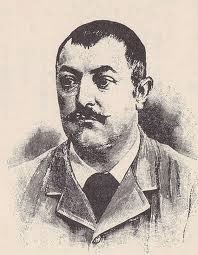 |
| Georges Ferdinand Bigot |
His background
Have you ever heard the name Georges Bigot, or seen his art works? He was famous as an artist and a cartoonist. He was born in 1860 in France. His mother graduated from a famous artist school and he lived around arts so he was interested in arts and paintings. After graduating from art school, he met a French artist known to be a Japanese art enthusiast and he learned about Japanese arts or Japan from him so he became interested in them. In 1882, he came to Japan and he worked at Japanese military as a foreigner employee. After that, he taught French at Nakae Chomin’s school and he contacted Chomin’s apprentices, so he learned of campaign for democratic rights. Because of this experience, he began painting critical cartoons. In 1887, he published “TOBAE” to criticize Japanese government for foreigners living in Japan. In 1893, before coming back France, he moved to Inage, Chiba and in same year he followed Japanese military to record Sino- Japanese war. In 1889, he came back France.
Three elements influenced his life. First is his mother and his friend, second is Nakae Chomin and third is Sino-Japanese war. I suggested that the first influence was his mother and his friend. His mother graduated from a famous art school so he was interested in arts. When he was 8 years old, he drew states of the Paris commune. His art style of painting real life also came from this experience. In addition he met his friend who liked Japanese arts. At first when he met his friend, he was taught Japanese ukie, not critical cartoon. However he could know Japanese art, he wanted to go to Japan.
Next is Nakae Chomin. Bigot taught French in Chomin’s school. Its school was attended by students who achieved the campaign for democratic rights. So Bigot could know Japan’s politics and he began to paint critical cartoons. At that time Japanese government wanted to change a treaty between Japan and other countries. However Bigot disagreed with this opinion, and thought it was too early to change them. So he criticized Japanese government with his cartoons.
Last influence is Sino-Japanese war. Bigot followed Japanese military to record this war. He painted hospitals of the battlefield or soldiers who did trivial works. In Russo –Japan war, he was asked to paint its war.
My influence
| Indiscriminate imitation |
Explaining our discussion
I would like to explain our group discussion. My first discussion question was “If you lived in that time, and you saw Bigot’s picture, what would you have felt?’ Second is “Bigot was not famous in France but he was famous in Japan, so do you think he was happy or unhappy?” Last question is “what are differences between Edoardo Chiossone [an Italian portrait artist described in other posts on this blog - Ed] and Bigot?”
First discussion question was “If you lived in that time, and you saw Bigot’s picture, what would you have felt?’ A group member said if I could understand that the pictures looked down on Japan, I would have gotten angry. Other members said they would have got angry or sad.
Second question was “Bigot was not famous in France but he was famous in Japan, so do you think he was happy or unhappy?” A member said he might have been happy because he was interested in Japan and loved Japan. In addition I explained that he got award for his picture which he painted in Inage, so after hearing this fact, members said he was so happy because he painted his favorite view in Japan, so he was happy.
Last question is “what are differences between Chiossone and Bigot?” My group member introduced Chiossone who was Italian painter and he painted Japanese good points or contributed to Japanese government. They were opposite, so what are differences? A member mentioned Bigot just joked and he did not really criticize Japan. Because he loved Japan and he wanted to introduce real Japan to foreign countries.
Thanks to this presentation, I could know details of Bigot and I want to research him more. Many foreigners who I do not know contributed to Japan. Present Japan is made by not only Japanese but also foreigners.
References
Bigot’s Wikipedia
http://ja.wikipedia.org/wiki/%E3%82%B8%E3%83%A7%E3%83%AB%E3%82%B8%E3%83%A5%E3%83%BB%E3%83%93%E3%82%B4%E3%83%BC
http://en.wikipedia.org/wiki/Georges_Ferdinand_Bigot
No comments:
Post a Comment